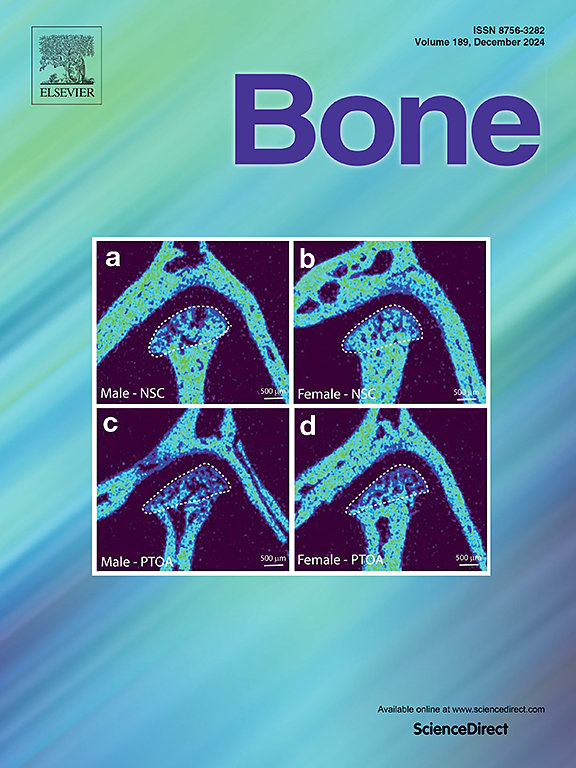Characterization of strains induced by in vivo locomotion and axial tibiotarsal loading in a chukar partridge model
IF 3.5
2区 医学
Q2 ENDOCRINOLOGY & METABOLISM
引用次数: 0
Abstract
Rodent models have offered valuable insights into the mechanobiological mechanisms that regulate bone adaptation responses to dynamic mechanical stimuli. However, using avian models may provide new insights into the mechanisms of bone adaptation to dynamic loads, as bird bones have distinct features that differ from mammalian bones. This paper illuminates these aspects by evaluating the mechanical environment in a novel avian, chukar partridge tibiotarsus (TBT), during fast locomotion and in cortical and cancellous tissue under in vivo dynamic compressive loading within the TBT. We measured in vivo mechanical strains at the TBT midshaft on the anterior, medial, and posterior surfaces during locomotion at various treadmill speeds. The mean in vivo strains measured on the anterior, medial, and posterior surfaces of the TBT midshaft were 154 με, -397 με, and -438 με, respectively, at a treadmill speed of 2 m/s. The mean experimentally measured strains on the anterior, medial, and posterior surfaces of the TBT were 114.7 με, -952.6 με, and -593.7 με under an in vivo dynamic compressive load of 130 N. The study, which employs a micro-computed tomography (microCT) based finite element model in combination with diaphyseal strain gauge measures, found that cancellous strains were greater than those in the midshaft cortical bone. Sensitivity analyses revealed that the material property of cortical bone was the most significant model parameter. In the midshaft cortical volume of interest (VOI), daily dynamic loading increased the maximum moment of inertia and reduced the bone area in the loaded limb compared to the contralateral control limb after three weeks of loading. Despite the strong correlations between the computationally modeled strains and experimentally measured strains at the medial and posterior gauge sites, no correlations existed between the computationally modeled strains and strain gradients, and histologically measured bone formation thickness at the mid-diaphyseal cross-section of the TBT.
楚卡鹧鸪模型体内运动和轴向胫跖载荷诱导的菌株特征
啮齿动物模型为调节骨适应对动态机械刺激的机械生物学机制提供了有价值的见解。然而,使用鸟类模型可能为骨骼适应动态载荷的机制提供新的见解,因为鸟类骨骼具有不同于哺乳动物骨骼的明显特征。本文通过评估一种新型鸟类楚卡鹧鸪(chukar partridge tibiotarsus, TBT)在快速运动过程中以及在TBT体内动态压缩载荷下皮质和松质组织中的机械环境来阐明这些方面。在不同跑步机速度下运动时,我们测量了TBT中轴前、中、后表面的体内机械应变。在跑步机速度为2 m/s时,在TBT中轴前、中、后表面测得的体内平均应变分别为154 με、-397 με和-438 με。在130 n的体内动态压缩载荷下,TBT前、中、后表面的平均实验测量应变分别为114.7 με、-952.6 με和-593.7 με。采用基于微计算机断层扫描(microCT)的有限元模型结合干骺端应变仪测量,发现松质应变大于中轴皮质骨应变。敏感性分析显示,皮质骨的材料特性是最重要的模型参数。在中轴皮质感兴趣体积(VOI)中,与对侧对照肢体相比,每日动态加载增加了加载肢体的最大惯性矩,并减少了加载肢体的骨面积。尽管计算模型应变与实验测量的内侧和后部应变之间存在很强的相关性,但计算模型应变与应变梯度以及TBT中骨干截面组织学测量的骨形成厚度之间不存在相关性。
本文章由计算机程序翻译,如有差异,请以英文原文为准。
求助全文
约1分钟内获得全文
求助全文
来源期刊

Bone
医学-内分泌学与代谢
CiteScore
8.90
自引率
4.90%
发文量
264
审稿时长
30 days
期刊介绍:
BONE is an interdisciplinary forum for the rapid publication of original articles and reviews on basic, translational, and clinical aspects of bone and mineral metabolism. The Journal also encourages submissions related to interactions of bone with other organ systems, including cartilage, endocrine, muscle, fat, neural, vascular, gastrointestinal, hematopoietic, and immune systems. Particular attention is placed on the application of experimental studies to clinical practice.
 求助内容:
求助内容: 应助结果提醒方式:
应助结果提醒方式:


